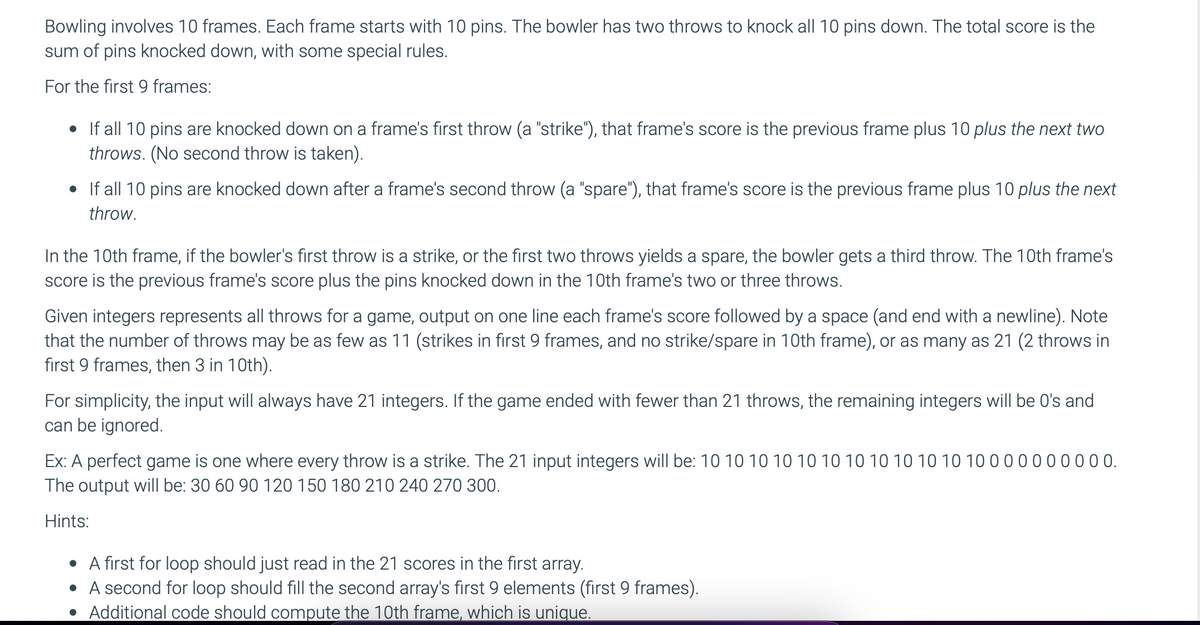Bowling involves 10 frames. Each frame starts with 10 pins. The bowler has two throws to knock all 10 pins down. The total score is the sum of pins knocked down, with some special rules. For the first 9 frames: • If all 10 pins are knocked down on a frame's first throw (a "strike"), that frame's score is the previous frame plus 10 plus the next two throws. (No second throw is taken). • If all 10 pins are knocked down after a frame's second throw (a "spare"), that frame's score is the previous frame plus 10 plus the next throw. In the 10th frame, if the bowler's first throw is a strike, or the first two throws yields a spare, the bowler gets a third throw. The 10th frame's score is the previous frame's score plus the pins knocked down in the 10th frame's two or three throws. Given integers represents all throws for a game, output on one line each frame's score followed by a space (and end with a newline). Note that the number of throws may be as few as 11 (strikes in first 9 frames, and no strike/spare in 10th frame), or as many as 21 (2 throws in first 9 frames, then 3 in 10th). For simplicity, the input will always have 21 integers. If the game ended with fewer than 21 throws, the remaining integers will be O's and can be ignored. Ex: A perfect game is one where every throw is a strike. The 21 input integers will be: 10 10 10 10 10 10 10 10 10 10 10 10 000000000. The output will be: 30 60 90 120 150 180 210 240 270 300. Hints: • A first for loop should just read in the 21 scores in the first array. • A second for loop should fill the second array's first 9 elements (first 9 frames). • Additional code should compute the 10th frame, which is unique.
PLEASE READ. I WILL REPORT YOU IF YOU JUST COPY AND PASTE THE WRONG ANSWER.
I need answer in JAVA.
instructor gave a hint ( I will include down below ) and I can not figure out rest of them.
import java.util.Scanner;
public class Main {
public static void main(String[] args) {
Scanner scnr = new Scanner(System.in);
int[] throwValues = new int[21];
int[] frameScores = new int[10];
int t; // Throw index
int f; // Frame index
int frameScore;
// Read in the 21 possible throw values for the 10 frames
for (t = 0; t < 21; ++t) {
throwValues[t] = scnr.nextInt();
}
// Compute scores
// output
for (f = 0; f < 10; ++f) {
System.out.print(frameScores[f] + " ");
}
System.out.println();
}
}
the code that I'm including is not an answer. there are more to add but I can't figure it out what to do. PLEASE HELP

![Main.java
Load default template...
1 import java.util.Scanner;
2
3 public class Main {
public static void main(String[] args) {
4
5
Scanner scnr
new Scanner(System.in);
7 /* Type your code here. *
}
9 }
8](/v2/_next/image?url=https%3A%2F%2Fcontent.bartleby.com%2Fqna-images%2Fquestion%2F362eddf6-5d35-4699-896e-c3739e02ebfd%2F394fb2b1-65c4-49c3-b46a-e1988a1c1246%2F7c3qu93_processed.png&w=3840&q=75)
Trending now
This is a popular solution!
Step by step
Solved in 3 steps with 3 images









